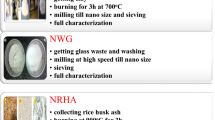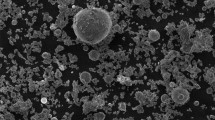Abstract
The corrosion rate of reinforcing steel present in high-performance concrete (HPC) was examined in the presence of nano fly ash, nano-silica fume, and nano coal as nano-waste material (NFA, SF, NC), respectively. A replacement to ordinary Portland cement (OPC) was carried out to some extent with nano-waste materials at 1, 2, 3, 4, 5, and 6% by cement weight to yield the (NFA, NSF, NC) HPC, as well as different percentages of NS (1, 2, 3 and 4%) were used. The corrosion rate of reinforcing steel present in HPC and nano-silica- and nano-waste materials-HPC was monitored and estimated using the half-cell potential (HCP). In addition to, water permeability, water absorption and aggressive attack media (immersed in sewage water) of hardened HPC and nano-silica- and nano-waste materials-HPC were also studied. All the samples of steel reinforcement were immersed in Qaron’s Lake water up to 6 months of exposure. The lowest corrosion rate results, compared with ordinary HPC, were obtained when nano-silica and nano-waste materials were used in concentrations 3,4, 4 and 2% (NS, NFA, NSF, and NC), respectively. Furthermore, HPC implanted with nano-silica (NS) is slightly better results than NFA. From the obtained data, the replacement with NFA gives the best milled waste material compared to NSF and NC, which improve the durability of nano fly ash-HPC.

















Similar content being viewed by others
References
AI-Khalaf, M. N., & Yousift, H. A. (1984). Use of rice husk ash in concrete. International Journal of Cement Composites and Lightweight Concrete, 6(4), 241–248.
Al-Amoudi, O. S. B., & Maslehuddin, M. (1991). Carbonation and corrosion of rebars in salt contaminated OPC/PFA concretes. Cement and Concrete Research, 21(1), 38–50.
Alsalman, A., Dang, C. N., & Hale, W. M. (2017). Development of ultra-high performance concrete with locally available materials. Construction and Building Materials, 133, 135–145.
Aly, M., Olabl, M. S. J., Messelry, M., Abadlr, E. F., & Hussain, A. I. (2012). Effect of colloidal nano-silica on the mechanical and physical behaviour of waste-glass cement mortar. Materials and Design, 33, 127–135.
Amin, M., & Abu el-hassan, K. (2015). Effect of using different types of nano materials on mechanical properties of high strength concrete. Construction and Building Materials, 80, 116–124.
Bahadori, H., & Hosseini, P. (2012). Reduction of cement consumption by the aid of silica nanoparticles (investigation on concrete properties). Journal of Civil Engineering and Management, 18(3), 416–425.
Borner, I., & Eckert, J. (1997). Nanostructure formation and steady-state grain size of ball-milled iron powders. Materials Science and Engineering A, 226–228, 541–545.
Cao, W., Wan, X., & Zhao, T. (2011). Influencing parameters analysis of chloride threshold value on reinforcements embedded in concrete. Advanced Materials Research, 250–254, 202–206.
Castro, C. L. D., Mitchell, B. S., & Baraton, M.-I. (2002). Nanoparticles from Mechanical Attrition. In: M. I. Baraton (Ed.), Synthesis, Functionalization and surface treatment of nanoparticles (pp. 1–15). USA: American Scientific Publishers, Valencia, CA.
Dehwah, H. A. F., Maslehuddin, M., & Austin, S. A. (2002). Effect of cement alkalinity on pore solution chemistry and chloride-induced reinforcement corrosion. ACI Material Journal, 99(3), 227–235.
Elkady, H., & Serag, M. I. (2013). Effect of nano silica de-agglomeration, and methods of adding super-plasticizer on the compressive strength, and workability of nano silica concrete. Civil and Environmental Research, 3(2), 21–34.
Elsener, B. (2000). Corrosion and environmental degradation. In: M. Schutze (Ed.), Weinheim: Willey-VCH, pp. 389–436.
Fadzil, A. M., Norhasri, M. S. M., Hamidah, M. S., Zaidi, M. R., Faizal, J. M. (2014). Alteration of nano metakaolin for ultra high performance concrete. Springer Science & Business Media Singapore, InCISE 2013 conference paper, pp. 887–894.
Ghafoori, N., Batilov, L., & Najimi, M. (2016). Sulfate Resistance of Nanosilica and Microsilica Contained Mortars. ACI Materials Journal, 113(4), 459–470.
Ghafoori, N., Batilov, L., & Sharbaf, M. (2018). Sodium Sulfate Resistance of Mortars Containing Combined Nanosilica and Microsilica. Journal of Materials in Civil Engineering, 30(7), 1–11.
Hanifi, B., Orhan, A., Bahsude, G., Hasan, K., & Mehmet, B. (2008). Performance of ground blast furnace slag and ground basaltic pumice concrete against seawater attack. Construction and Building Materials, 22(7), 1515–1526.
Hartt, W. H., & Nam, J. (2008). Effect of cement alkalinity on chloride threshold and timeto-corrosion of reinforcing steel in concrete. Corrosion, 64(8), 671–680.
Helal, N., El-Rabiee, M., Abd El-Hafez, Gh, & Badawy, W. (2008). Corrosion control of vanadium in aqueous solutions by amino acids. Alloys and Compounds, 459(1–2), 466–471.
Hosseini, P., Mohamad, M. I., Nekooie, M. A., Taherkhani, R., & Booshehrian, A. (2011). Toward green revolution in concrete industry: the role of nanotechnology (a review). Australian Journal of Basic and Applied Sciences, 5(12), 2768–2782.
Hosseinpourpia, R., Varshoee, A., Soltani, M., Hosseini, P., & Tabari, H. Z. (2012). Production of waste bio-fiber cement based composites reinforced with nano-SiO2 particles as a substitute for asbestos cement composites. Construction and Building Materials, 31, 105–111.
Hou, P., Kawashima, S., Kong, D., Corr, D. J., Qian, J., & Shah, S. P. (2013). Modification effects of colloidal nanoSiO2 on cement hydration and its gel property. Composites Part B Engineering, 45, 440–448.
Ismail, M., Muhammad, B., & Hamzah, E. (2012). Corrosion behaviour of dual-phase and galvanized steels in concrete. Anti-Corrosion Methods and Materials, 59(3), 4–4.
Ji, T. (2005). Preliminary study on the water permeability and microstructure of concrete incorporating nano-SiO2. Cement and Concrete Research, 35, 1943–1947.
Jo, B. W., Kim, C. H., & Lim, J. H. (2007). Investigations on the development of powder concrete with nano-SiO2 particles. KSCE Journal of Civil Engineering, 11(1), 37–42.
Junyig, B., Hongmei, A., & Puguang, L. (2011). Effect of oxygen ions diffusion on steel corrosion in concrete. Key Engineering Material, 477, 398–403.
Khan, M. I., Mourad, S. M., & Charif, A. (2017). Utilization of supplementary cementitious materials in HPC: From rheology to pore structure. KSCE Journal of Civil Engineering, 21(3), 889–890.
Klefenz, H. (2004). Nanobiotechnology: From molecules to systems. Engineering in Life Science, 4(3), 211–218.
Kropp, J. K., Hilsdorf, H. K. (1995). Performance criteria for concrete durability. 1st edition E&FN SPON, London, UK, RILEM Report 12.
Mareno, M., Morris, W., Alvarez, M. G., & Duffo, G. S. (2004). Corrosion of reinforcing steel in simulated concrete pore solutions—Effect of carbonation and chloride content. Corrosion Science, 46, 2681–2699.
Mehta, P. K., Burrows, R. W. (2001), Building Durable Structures. In The 21st Century, Concrete International, 23(3), 57–63.
Olawuyi, B. J., & Boshoff, W. P. (2017). Influence of SAP content and curing age on air void distribution of high performance concrete using 3D volume analysis. Construction and Building Materials, 135, 580–589.
Qiao, G., & Ou, J. (2007). Corrosion monitoring of reinforcing steel in cement mortar by EIS and ENA. Electrochimica Acta, 52, 8008–8019.
Quercia, G., Husken, G., & Brouwers, H. J. H. (2012). Water demand of amorphous nano silica and its impact on the workability of cement paste. Cement and Concrete Research, 42, 344–357.
Rahimand, A., & Nair, S. R. (2016). Influence of nano-materials in high strength concrete. Journal of Chemical and Pharmaceutical Sciences, 3, 15–22.
Samples. L, Ramirez, J. (1999). Methods of Corrosion Protection and Durability of Concrete Bridge Decks Reinforced with Epoxy-Coated Bars—Phase I. Purdue University: FHWA/IN/JTRP-98/15.
Schiessl, P. (1988). Corrosion of steel in concrete. RILEM Technical Commitee, 60-CSC. Chapman & Hall: New York.
Senff, L., Labrincha, J. A., Ferreira, V. M., Hotza, D., & Repette, W. L. (2009). Effect of nano-silica on rheology and fresh properties of cement pastes and mortars. Construction and Building Materials, 23, 2487–2489.
Shi, X., Xie, N., Fortune, K., & Gong, J. (2012). Durability of steel reinforced concrete in chloride environments: An overview. Construction and Building Materials, 30, 125–138.
Sistani, P., Sofimaryo, L., Masoudi, Z., Sayad, A., Rahimzadeh, R., & Salehi, B. (2014). A penicillin biosensor by using silver nanoparticles. International Journal of Electrochemical Science, 9, 6201–6212.
Supit, S. W. M., & Shaikh, F. U. A. (2015). Durability properties of high volume fly ash concrete containing nano-silica. Materials and Structures, 48, 2431–2445.
Tran, N. T., & Kim, D. J. (2017). Synergistic response of ultra high performance concrete at high strain rates. Cement & Concrete Composites, 78, 132–145.
Wang, B. (2011). Influence of nano-SiO2 on the strength of high performance concrete. Materials Science Forum, 686, 432–437.
Xizhen, Y., Wu, Y. (1996). High performance concrete. Chemical Industry Press: Beijing, Chap. 3.
Xu, J., Jiang, L., Wang, W., Xu, Y., & Jiang, Y. (2011). Chloride threshold value for reinforcement corrosion in concrete with additions of silica fume or fly ash. Magazine of Concrete Research, 63(12), 905–913.
Yu-xi, A. (2013). Effect of nano materials on durability of high performance concrete. Advanced Materials Research, 742, 220–223.
Zhang, P., Li, Q., Zhang, H.(2012). Fracture properties of high performance concrete containing fly ash. Proceedings of the Institution of Mechanical Engineers, Part L: Journal of Materials Design and Applications, 226(2), 170–176.
Zhang, P., Liu, C., & Li, Q. (2011). Application of gray relational analysis for chloride permeability and freeze-thaw resistance of high-performance concrete containing nanoparticles. Journal of Materials in Civil Engineering, 23(12), 1760–1763.
Zhang, P., Liu, C. H., QF, Zhang, & Wang, T. H. P. (2014). Flexural Toughness of of steel fiber reinforced high performance concrete containing nano-SiO2 and fly ash. The scientific world journal, 106(7), 1–11.
Author information
Authors and Affiliations
Corresponding author
Ethics declarations
Conflict of interest
There is no conflict of interest.
Rights and permissions
About this article
Cite this article
Tawfik, T.A., El-Yamani, M.A., Abd El-Aleem, S. et al. Effect of nano-silica and nano-waste material on durability and corrosion rate of steel reinforcement embedded in high-performance concrete. Asian J Civ Eng 20, 135–147 (2019). https://doi.org/10.1007/s42107-018-0093-5
Received:
Accepted:
Published:
Issue Date:
DOI: https://doi.org/10.1007/s42107-018-0093-5




